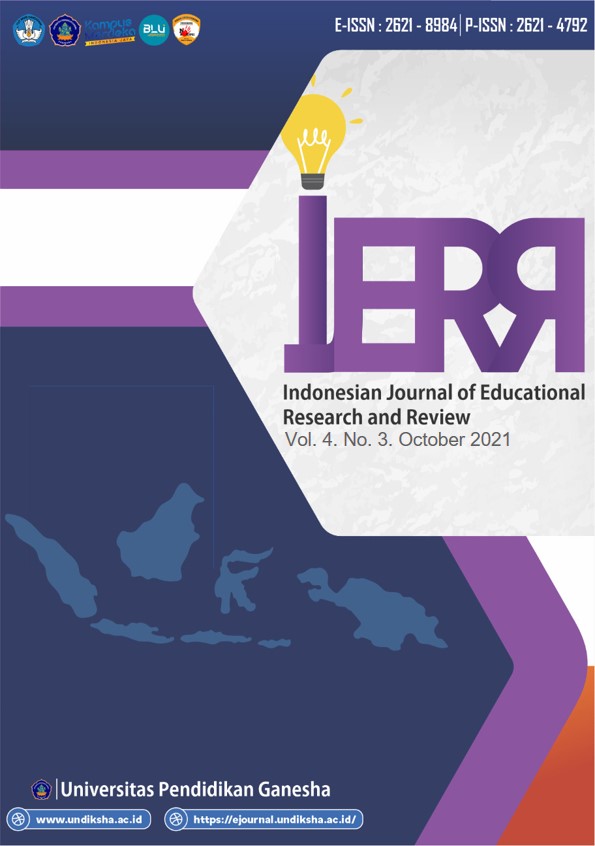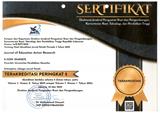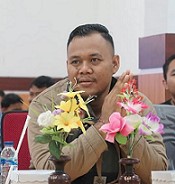E-Summary Teaching Materials with Hannafin & Peck Models for Training Participants in the Human Resources Development Agency
DOI:
https://doi.org/10.23887/ijerr.v4i3.40131Keywords:
e-summary, development, hannafin & peck.Abstract
This study aims to describe the design of electronic teaching materials packaged in e-summary form, and to determine the validity of e-summary teaching materials according to experts and product trials. This type of research is development research using the Hannafin & Peck model. The types of data in this study are quantitative and qualitative data. The research data collection used the document recording method and the questionnaire method. The data analysis technique used is descriptive quantitative analysis technique, and descriptive qualitative. The results of the study (1) The design of this e-summary teaching material consists of three stages, namely the needs analysis stage, the design stage, the development and implementation stage. And at each stage it passes through the evaluation stage. (2) The validity of the development of e-summary teaching materials is measured through (a) the results of the content/content expert review by obtaining a percentage of 93.3% being in very good qualification, (b) the results of the e-summary linguist review being 87.5% being on good qualifications (c) the results of the review of individual trials show that the percentage of the overall subject is 97.1% with very good qualifications and (d) the results of the small group trial review show that the percentage of the overall subject is 96.3% with very good qualifications. . In general, the research results show that e-summary is valid with very good quality and is suitable for use in the learning process in creative thinking training. Suggestions that can be given from the results of this study are that this e-summary teaching material can be used optimally in the learning process so that it can increase the training participants' self-study motivation and make it easier to understand the training material.
References
Afifah, E., Triyono, T., & Hotifah, Y. (2016). Pengembangan Media Letter Sharing Untuk Meningkatkan Keterampilan Komunikasi Siswa Introvert. Jurnal Kajian Bimbingan Dan Konseling, 1(2), 27–32. https://doi.org/10.17977/um001v1i12016p027.
Agung, A. A. G. (2014). Buku Ajar Metodelogi Penelitian Pandidikan. Aditya Media Publishing.
Arikunto, S. (2013). Dasar-Dasar Evaluasi Pendidikan. Bumi Aksara.
Astra, I. M., Raihanati, R., & Mujayanah, N. (2020). Development of Electronic Module Using Creative Problem-Solving Model Equipped with Hots Problems on The Kinetic Theory of Gases Material. Jurnal Penelitian & Pengembangan Pendidikan Fisika, 6(2), 181–194. https://doi.org/10.21009/1.06205.
Ati, R. (2012). Pengaruh Kompetensi Dan Komitmen Guru Pendidikan Kewarganegaraan Dalam Mengimplementasikan Pendidikan Karakter Terhadap Hasil Belajar Siswa: Studi Deskriptif di SMP Negeri Kota Bandung. Universitas Pendidikan Indonesia.
Butow, P., & Hoque, E. (2020). Using artificial intelligence to analyse and teach communication in healthcare. Breast, 50, 49–55. https://doi.org/10.1016/j.breast.2020.01.008.
Darmadi, H. (2016). Tugas, peran, kompetensi, dan tanggung jawab menjadi guru profesional. Edukasi: Jurnal Pendidikan, 13(2), 161–174. http://www.journal.ikippgriptk.ac.id/index.php/edukasi/article/view/113.
Huang, S. Y., Kuo, Y. H., & Chen, H. C. (2020). Applying digital escape rooms infused with science teaching in elementary school: Learning performance, learning motivation, and problem-solving ability. Thinking Skills and Creativity, 37(129), 100681. https://doi.org/10.1016/j.tsc.2020.100681.
Juniarti, Y.-A. J. P. (2019). Pengembangan Media Ludo Geometri (DORI) pada Fisik Motorik Anak Usia Dini. Al-Athfal Jurnal Pendidikan Anak, 5(2), 169–182. https://doi.org/https://doi.org/10.14421/al-athfal.2019.52-04.
Linggi, Y. (2021). Pengaruh Kompetensi dan Motivasi Kerja Terhadap Kinerja Guru Otomotif SMK Kristen Tagari Toraja Utara. Jurnal Pendidikan Tambusai, 5(1), 507–513. https://doi.org/10.33603/jibm.v3i1.2191.
Minawati, Z., Haryani, S., & Pamelasari, S. D. (2014). Pengembangan Lembar Kerja Siswa IPA Terpadu Berbasis Inkuiri Terbimbing Pada Tema Sistem Kahidupan Dalam Tumbuhan Untuk Smp Kelas VIII. In USEJ - Unnes Science Education Journal (Vol. 3, Issue 3, pp. 587–592). https://doi.org/10.15294/usej.v3i3.4265.
Nurzaelani, M. M., Kasman, R., & Achyanadia, S. (2018). Pengembangan Bahan Ajar Integrasi Nasional Berbasis Mobile. Jurnal Teknologi Pendidikan, 20(3).
Popescu, A.-D., Suciu, S., & Raoult, M.-G. (2014). Intercultural Competences in Collaborative Teams. Procedia Technology, 12, 577–582. https://doi.org/10.1016/j.protcy.2013.12.532.
Purwanto, Y., & Rizki, S. (2015). Pengembangan Bahan Ajar Berbasis Kontekstual Pada Materi Himpunan Berbantu Video Pembelajaran. AKSIOMA Journal of Mathematics Education, 4(1), 67–77. https://doi.org/10.24127/ajpm.v4i1.95.
Saidah, K., & Damariswara, R. (2019). Pengembangan Bahan Ajar Materi Dongeng Berbasis Kearifan Lokal Jawa Timur Bagi Siswa Kelas III SD. Premiere Educandum : Jurnal Pendidikan Dasar Dan Pembelajaran, 9(1), 73. https://doi.org/10.25273/pe.v9i1.4320.
Snegurenko, A. P., Sosnovsky, S. A., Novikova, S. V., Yakhina, R. R., Valitova, N. L., & Kremleva, E. S. (2019). Using e-learning tools to enhance students-mathematicians’ competences in the context of international academic mobility programmes. Integration of Education, 23(1), 8–22. https://doi.org/10.15507/1991-9468.094.023.201901.008-022.
Sormin, D. (2016). Kompetensi Guru Dalam Melaksanakan Dan Mengelola Proses Belajar Mengajar Di Pondok Pesantren Darul Mursyidi Desa Sialogo Tapanuli Selatan. FITRAH:Jurnal Kajian Ilmu-Ilmu Keislaman, 2(1), 117. https://doi.org/10.24952/fitrah.v2i1.459.
Suciu, A. I., & Mata, L. (2011). Pedagogical Competences – The Key to Efficient Education. International Online Journal of Educational Sciences, 3(2), 411–423. https://www.acarindex.com/dosyalar/makale/acarindex-1423904375.pdf.
Supriyono, A. (2017). The Influence Of Pedagogic, Professional Competency, And Work Motivation Onteacher Performance Of Elementary School. Jurnal Pendidikan, 18(2), 1–12.
Taqiyyah, S. A., Subali, B., & Handayani, L. (2017). Implementasi Bahan Ajar Sains Berbahasa Inggris Berbasis Metakognitif Untuk Meningkatkan Kemampuan Pemecahan Masalah Siswa SMP. Jurnal Inovasi Pendidikan IPA, 3(2), 224–234. https://doi.org/10.21831/jipi.v3i2.14859.
Tegeh, I. M., & Jampel, I. N. (2017). Metode Penelitian Pengembangan. Universitas Pendidikan Ganesha.
Tegeh, M., Pudjawan, K., & Jampel, N. (2015). Model Penelitian Pengembangan. Graha Ilmu.
Wahyono, P., Husamah, H., & Budi, A. S. (2020). Guru profesional di masa pandemi COVID-19: Review implementasi, tantangan, dan solusi pembelajaran daring. Jurnal Pendidikan Profesi Guru, 1(1), 51–65. http://ejournal.umm.ac.id/index.php/jppg/article/view/12462.
Yani, R. (2016). Pengembangan Instrumen dan Bahan Ajar untuk Meningkatkan Kemampuan Komunikasi, Penalaran, dan Koneksi Matematis dalam Konsep Integral. Jurnal Penelitian Pendidikan, 13(1), 44–52.
Downloads
Published
How to Cite
Issue
Section
License
Authors who publish with the Indonesian Journal of Educational Research and Review (IJERR) agree to the following terms:
- Authors retain copyright and grant the journal the right of first publication with the work simultaneously licensed under a Creative Commons Attribution License (CC BY-SA 4.0) that allows others to share the work with an acknowledgment of the work's authorship and initial publication in this journal.
- Authors are able to enter into separate, additional contractual arrangements for the non-exclusive distribution of the journal's published version of the work (e.g., post it to an institutional repository or publish it in a book), with an acknowledgment of its initial publication in this journal.
- Authors are permitted and encouraged to post their work online (e.g., in institutional repositories or on their website) prior to and during the submission process, as it can lead to productive exchanges, as well as earlier and greater citation of published work. (See The Effect of Open Access)












